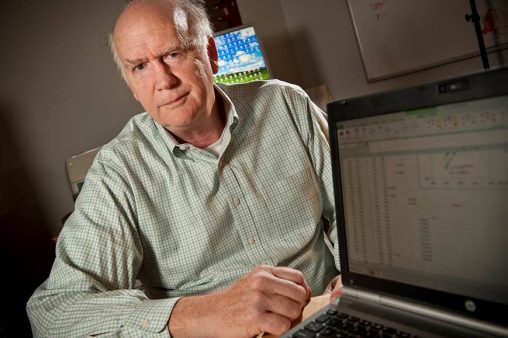
Allen Hunt, professor of physics at Wright State, has published a new research paper in the journal AGU Advances.
Allen Hunt, Ph.D., professor of physics at Wright State University, published a new co-authored paper, “Predicting Streamflow Elasticity Based on Percolation Theory and Ecological Optimality,” in the journal AGU Advances.
AGU is a global community supporting more than half a million advocates and professionals in the Earth and space sciences.
Hunt’s paper showcases a new model for determining the response of streams worldwide, including the world’s major river basins, to the fundamental products of climate change, including changing temperature, solar irradiance, humidity, winds and precipitation.
Based on the 2021 paper “Predicting characteristics of the water cycle from scaling relationships,” on which Hunt was the lead author, this model has been proven to be more accurate than the most widely used model.
The impact that global warming has had on freshwater resources has been a contributing factor in growing water insecurity worldwide. The United Nations estimates that over 1 billion people currently have inadequate or no access to potable water and that number will rise to between 2 to 3 billion by 2050. The problem doesn’t end with drinking water; it also extends into industrial and agricultural use.
Hunt said the accuracy of this new model will have implications for the entire field of hydrology and will help guide global climate change policies. It is known that with rising temperatures the atmosphere holds more water, but just holding more water doesn’t mean that more rain will fall in a particular area.
“The issue of water resources in this century is critical due to climate change,” said Hunt. “You’ve got too much or too little all over the place. For example, Sacramento recently picked up six inches of rain in one day, which is half their yearly rainfall. They didn’t get anything for 200 days before or 100 days afterwards.”
And while there is a highly variable component, on average, places that are currently dry will get dryer and wet places will get wetter, he said.
The 2021 paper, which was published in the American Geophysical Society’s Water Resources Research, presented a solution to what in 1931 the “father of hydrology,” Robert Horton, called the Central Problem in Hydrology, which is the water balance. This solution was based on a new ecological principle, that the plant ecosystem, which is most successful at taking carbon out of the atmosphere to produce plant mass, will have an evolutionary advantage. The ecological basis of the theory has been supported by an independent study with a dynamic process model, which produced the same result for evapotranspiration from optimizing carbon profit at the cellular level.
“Precipitation goes into runoff, evapotranspiration and changes in storage. That’s called the water balance. The hard part about this is predicting how much goes into evapotranspiration, which is defined as the process by which water is transferred from the land to the atmosphere by evaporation from the soil and other surfaces and by transpiration from plants,” said Hunt. “You need to be able to predict that as a function of the climate. That is, how much rainfall you get as well as how much energy from the sun. We did that in a paper in 2021.”
It was this result that made the newly published paper possible.
Hunt said the processes determined by the water balance, such as erosion and formation of soil, and evapotranspiration, which controls vegetation productivity, are crucial to providing a carbon sink, critical in the future of Earth’s climate and recognized as an important component in climate models since Nobel laureate Syukuro Manabe’s classic work from the 1960s.
Publication of the new research in AGU Advances recognizes the work as a theoretical advance in the science of water.

 Milling around
Milling around  Wright State recognizes Nursing Professor Kim Ringo for advancing international student success
Wright State recognizes Nursing Professor Kim Ringo for advancing international student success  Wright State honors graduating students for distinguished doctoral dissertations
Wright State honors graduating students for distinguished doctoral dissertations  Top 10 Newsroom videos of 2025
Top 10 Newsroom videos of 2025  Museum-quality replica of historic Hawthorn Hill donated to Wright State
Museum-quality replica of historic Hawthorn Hill donated to Wright State 